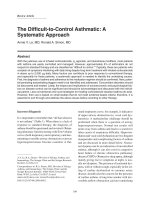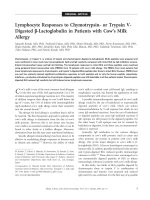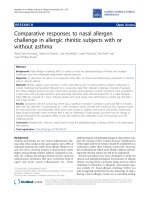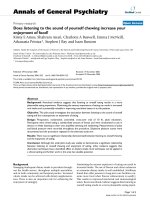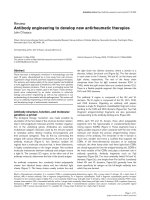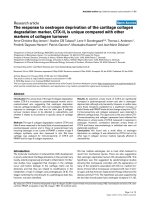Báo cáo y học: "Number needed to treat = six: therapeutic hypothermia following cardiac arrest – an effective and cheap approach to save lives" pdf
Bạn đang xem bản rút gọn của tài liệu. Xem và tải ngay bản đầy đủ của tài liệu tại đây (35.18 KB, 2 trang )
Page 1 of 2
(page number not for citation purposes)
Available online />Abstract
In 2005, the European Resuscitation Council (ERC) guidelines
stated: Unconscious adult patients with spontaneous circulation
after out-of-hospital ventricular fibrillation cardiac arrest should be
cooled to 32 to 34°C for 12 to 24 hours. Patients with cardiac
arrest from a non-shockable rhythm, in-hospital patients and
children may also benefit from hypothermia. There is no argument
to wait. We have to treat the next unconscious cardiac arrest
patient with hypothermia.
The article “Efficacy of and tolerance to mild induced
hypothermia after out-of-hospital cardiac arrest using an
endovascular cooling system” by Pichon et al. in the previous
issue of Critical Care [1] points to a very relevant health care
issue. Only 10% of patients undergoing out-of-hospital
cardiopulmonary resuscitation are discharged alive from the
hospital. This high mortality is to a major part due to
ischaemic brain damage. In 2002, a European multicentre
trial on the use of mild therapeutic hypothermia – as well as
other clinical trials – clearly demonstrated a decrease in
mortality and a better neurological outcome in cardiac arrest
patients [2,3]. Only six patients have to be treated to save
one life (number needed to treat = six) [4]. This is far better
than with most other – expensive – approaches in the
intensive care unit (ICU) [5]. Consequently, therapeutic hypo-
thermia has been recommended in an Advisory Statement by
the International Liaison Committee on Resuscitation
(ILCOR) already in 2003 [6]. In 2005, the European
Resuscitation Council (ERC) guidelines stated [7]:
1. Unconscious adult patients with spontaneous circulation
after out-of-hospital ventricular fibrillation cardiac arrest
should be cooled to 32 to 34°C. Cooling should be
started as soon as possible and continued for at least 12
to 24 hours.
2. Induced hypothermia might also benefit unconscious
adult patients with spontaneous circulation after out-of-
hospital cardiac arrest from a non-shockable rhythm, or
cardiac arrest in hospital.
3. A child who regains a spontaneous circulation but
remains comatose after cardiopulmonary arrest may
benefit from being cooled to a core temperature of 32 to
34°C for 12 to 24 hours.
Therapeutic hypothermia influences postresuscitation brain –
and other organ – injury in many different ways: it reduces
metabolism, free radical formation, intracellular calcium
overload, as well as translation and transcription of patho-
genic proteins. Additionally, it has anti-apoptotic, anti-inflam-
matory and anti-coagulatory properties and can reduce
oedema formation [8].
There are few areas in emergency and intensive care
medicine where scientific evidence is so strong and where
international guidelines are so clear. Nevertheless,
implementation of hypothermia is lousy. In most countries on
both sides of the Atlantic, under 30% of cardiac arrest
patients are receiving hypothermia [9]. The reasons are
multifactorial. Colleagues are stating that they do not have
enough information and experience, that this therapy is not
evidence-based and that it is technically too difficult. Mild
therapeutic hypothermia is definitely underused post cardiac
arrest, and many patients who need not die are dying
because of this clinical reality.
Here, it is very important that independent groups do support
implementation of hypothermia. Pichon and colleagues report
on the efficacy and tolerance of a commercially available
intravascular cooling device used in 40 post cardiac arrest
patients [1]. Cooling with this device was safe, relatively fast
Commentary
Number needed to treat = six: therapeutic hypothermia following
cardiac arrest – an effective and cheap approach to save lives
Bernd W Böttiger, Andreas Schneider and Erik Popp
Department of Anaesthesiology, University of Heidelberg, Germany
Corresponding author: Bernd W Böttiger,
Published: 31 August 2007 Critical Care 2007, 11:162 (doi:10.1186/cc6100)
This article is online at />© 2007 BioMed Central Ltd
See related research by Pichon et al., />ERC = European Resuscitation Council; ICU = intensive care unit; ILCOR = International Liaison Committee on Resuscitation.
Page 2 of 2
(page number not for citation purposes)
Critical Care Vol 11 No 4 Böttiger et al.
and effective in maintaining the targeted temperature.
Regardless of the initial cardiac rhythm – about which the
brain does not care – all patient groups benefited from
cooling with this device. There are no clinical trials available
yet which compare outcome after different cooling
techniques. Clear recommendations for a specific method are
thus not possible. Maintenance of hypothermia is practicable
with both surface and endovascular cooling. In the past,
feedback mechanisms have been more sophisticated with
endovascular cooling devices. Very recent data on different
techniques of body surface cooling suggest that these
techniques are also able to maintain body temperature in a
clinically sufficient way [10].
Animal experimental data suggest that hypothermia is more
effective the faster it is established after the arrest [11]. Even
the five hours needed in the present study may be long.
Therefore, the use of other and faster methods to induce
hypothermia must be considered. Infusion of ice-cold
Ringer’s solution (30 ml/kg within 30 minutes) has been
shown to be an easy, cheap, effective and safe way of
inducing hypothermia in less than one hour [12]. This is even
possible in the out-of-hospital setting [13]. For subsequent
maintenance of hypothermia, intravascular and body surface
cooling techniques may both be effective and safe.
Well known side effects of therapeutic hypothermia, like
hypokalaemia, hypomagnesaemia and bacteraemia may
occur, and it is important to know this. Major complications
including arrhythmias, bleeding, pneumonia, sepsis et cetera,
however, do not occur more often in hypothermic as
compared to normothermic cardiac arrest patients [2,3]. The
most important ‘side effect’ of hypothermia is that it is not
used routinely in most cardiac arrest patients. There is no
good argument to wait any longer. According to Hippocrates,
we have to treat the next unconscious cardiac arrest patient
with mild therapeutic hypothermia, regardless of which
technique we are using.
Competing interests
The author(s) declare that they have no competing interests.
References
1. Pichon N, Amiel JB, Francois B, Dugard A, Etchecopar C, Vignon
P: Efficacy of and tolerance to mild induced hypothermia after
out-of-hospital cardiac arrest using an endovascular cooling
system. Crit Care 2007, 11:R71.
2. Bernard SA, Gray TW, Buist MD, Jones BM, Silvester W, Gut-
teridge G, Smith K: Treatment of comatose survivors of out-of-
hospital cardiac arrest with induced hypothermia. N Engl J
Med 2002, 346:557-563.
3. Hypothermia after Cardiac Arrest Study Group: Mild therapeutic
hypothermia to improve the neurologic outcome after cardiac
arrest. N Engl J Med 2002, 346:549-556.
4. Holzer M, Bernard SA, Hachimi-Idrissi S, Roine RO, Sterz F,
Müllner M: Hypothermia for neuroprotection after cardiac
arrest: systematic review and individual patient data meta-
analysis. Crit Care Med 2005, 33:414-418.
5. Bernard GR: Drotrecogin alfa (activated) (recombinant human
activated protein C) for the treatment of severe sepsis. Crit
Care Med 2003, 31:S85-S93.
6. International Liason Committee on Resuscitation: Therapeutic
hypothermia after cardiac arrest. An advisory statement by
the Advancement Life support Task Force of the International
Liaison committee on Resuscitation. Resuscitation 2003, 57:
231-235.
7. European Resuscitation Council: European Resuscitation
Council guidelines for resuscitation 2005. Resuscitation 2005,
67:S1-S189.
8. Popp E, Böttiger BW: Cerebral resuscitation: state of the art,
experimental approaches and clinical perspectives. Neurol
Clin 2006, 24:73-87.
9. Merchant RM, Soar J, Skrifvars MB, Silfvast T, Edelson DP,
Ahmad F, Huang KN, Khan M, Vanden Hoek TL, Becker LB,
Abella BS: Therapeutic hypothermia utilization among physi-
cians after resuscitation from cardiac arrest. Crit Care Med
2006, 34:1935-1940.
10. Haugk M, Sterz F, Grassberger M, Uray T, Kliegel A, Janata A,
Richling N, Herkner H, Laggner AN: Feasibility and efficacy of a
new non-invasive surface cooling device in post-resuscitation
intensive care medicine. Resuscitation 2007, in press.
11. Kuboyama K, Safar P, Radovsky A, Tisherman SA, Stezoski SW,
Alexander H: Delay in cooling negates the beneficial effect of
mild resuscitative cerebral hypothermia after cardiac arrest in
dogs: a prospective, randomized study. Crit Care Med 1993,
21:1348-1358.
12. Bernard S, Buist M, Monteiro O, Smith K: Induced hypothermia
using large volume, ice-cold intravenous fluid in comatose
survivors of out-of-hospital cardiac arrest: a preliminary
report. Resuscitation
2003, 56:9-13.
13. Virkkunen I, Yli-Hankala A, Silfvast T: Induction of therapeutic
hypothermia after cardiac arrest in prehospital patients using
ice-cold Ringer’s solution: a pilot study. Resuscitation 2004,
62:299-302.


